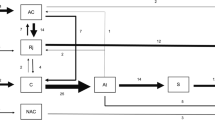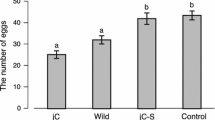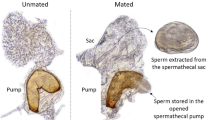Male competition for mates can occur through contests or a scramble to locate females. We examined the significance of contests for mates in the leaf beetle Chrysomela aeneicollis, which experiences a short breeding season. During peak mating season, 18–52% of beetles are found in male-female pairs, and nearly half of these are copulating. Sex ratios do not differ from parity, females are larger than males, and positive size-assortative mating occurs. Males fight (2–4% of beetles) over access to females, and disruption of mating usually follows these contests. In the laboratory, we compared mating and fighting frequencies for males found in mating pairs (field-paired) and single males placed into an arena with a field-paired female. Mating pairs were switched in half of arenas (new male-female pairs) and maintained in the other half. For 2 days, each male was free to move about and fight; thereafter males were tethered to prevent contests. Mating frequencies were significantly greater for field-paired than single males in both situations. Male size was not related to mating frequency; however, large females received more matings than small ones. These data suggest that males fight for high quality females, but otherwise search for as many matings as possible.




Similar content being viewed by others
REFERENCES
Alcock, J. (1998). Animal Behavior: An Evolutionary Approach. Sinauer Associates, Sunderland, MA.
Arnaud, L., and Haubruge, E. (1999). Mating behaviour and male mate choice in Tribolium castaneum(Coleoptera, Tenebrionidae). Behaviour 136:67–77.
Bateman, P. W. (1998). Assortative mating by both sexes in the cricket Platygryllus primiformis(Orthoptera: gryllidae; gryllinae). T. Am. Entomol. Soc. 124:63–68.
Baur, R., and Rank, N. E. (1996). Influence of host quality and natural enemies on the life history of the alder leaf beetles Agelastica alniand Linaeidea aenea. In Jolivet, P. H., and Cox, M. L. (eds.), Chrysomelidae Biology, SPB Publishing, Amsterdam, pp. 173–194.
Bean, D., and Cook, J. M. (2001). Male mating tactics and lethal combat in the nonpollinating fig wasp Sycoscapter australis. Anim. Behav. 62:535–542.
Bertin, A., and Cezilly, F. (2003). Sexual selection, antennae length and the mating advantage of large males in Asellus aquaticus. J. Evolution. Biol. 16:698–707.
Birkinshaw, L. A., and Smith, R. H. (2001). Prostephanus truncatusmate choice on contact: Does pheromone signalling by males affect their mating success? Entomol. Exp. Appl. 98:345–351.
Blanckenhorn, W. U. (2000). The evolution of body size: What keeps organisms small? Q. Rev. Biol. 75:385–407.
Blanckenhorn, W. U., and Viele, S. N. T. (1999). Foraging in yellow dung flies: Testing for a small-male time budget advantage. Ecol. Entomol. 24:1–6.
Blanckenhorn, W. U., Preziosi, R. F., and Fairbairn, D. J. (1995). Time and energy constraints and the evolution of sexual size dimorphism-to eat or to mate? Evol. Ecol. 9:369–381.
Brown, W. D. (1990). Size-assortative mating in the blister beetle Lytta magister(Coleoptera: Meloidae) is due to male and female preference for larger mates. Anim. Behav. 40:901–909.
Brown, W. D. (1993). The cause of size-assortative mating in the leaf beetle Trirhabda canadensis(Coleoptera: Chrysomelidae). Behav. Ecol. Sociobiol. 3:151–157.
Brown, W. J. (1956). The New World species of ChrysomelaL. (Coleoptera: Chrysomelidae). Can. Entomol. 88:5–54.
Bruce, D. A. (2005). Effects of PGI genotype and temperature on fecundity, mating success and running speed of a Sierra willow leaf beetle.Master’s thesis, Sonoma State University, Rohnert Park, CA.
Capone, T. A. (1995). Mutual preference for large mates in green stink bugs, Acrosternum hilare(Hemiptera: Pentatomatidae). Anim. Behav. 49:1335–1344.
Dahlhoff, E. P., and Rank, N. E. (2000). Functional and physiological consequences of genetic variation at phosphoglucose isomerase: Heat shock protein expression is related to enzyme genotype in a montane beetle. P. Natl. Acad. Sci. USA. 97:10056–10061.
delCastillo, R. C., NunezFarfan, J., and CanoSantana, Z. (1999). The role of body size in mating success of Sphenarium purpurascensin Central Mexico. Ecol. Entomol. 24:146–155.
Dickinson, J. L. (1986). Prolonged mating in the milkweed leaf beetle Labidomera clivicollis clivicollis(Coleoptera: Chrysomelidae): A test of the “sperm-loading” hypothesis. Behav. Ecol. Sociobiol. 18:331–338.
Dickinson, J. L. (1992). Scramble competition polygyny in the milkweed leaf beetle: Combat, mobility, and the importance of being there. Behav. Ecol. 3:32–41.
Dunn, D. W., Crean, C. S., Wilson, C. L., and Gilburn, A. S. (1999). Male choice, willingness to mate and body size in seaweed flies (Diptera: Coelopidae). Anim. Behav. 57:847–853.
Eberle, M., and Kappeler, P. M. (2004). Sex in the dark: Determinants and consequences of mixed male mating tactics in Microcebus murinus, a small solitary nocturnal primate. Behav. Ecol. Sociobiol. 57:77–90.
Goldsmith, S. K., Stewart, Z., Adams, S., and Trimble, A. (1996). Body size, male aggression, and male mating success in the Cottonwood Borer, Plectrodera scalator(Coleoptera: Cerambycidae). J. Insect Behav. 9:719–721.
Goulson, D., Bristow, L., Elderfield, E., Brinklow, K., Parry-Jones, B., and Chapman, J. W. (1999). Size, symmetry, and sexual selection in the housefly. Musca domestica. Evol. 53:527–534.
Hardy, I. C. W., and Field, S. A. (1998). Logistic analysis of animal contests. Anim. Behav. 56:787–792.
Hernandez, M. I., and Benson, W. W. (1998). Small-male advantage in the territorial tropical butterfly Heliconius sara(Nymphalidae): A paradoxical strategy? Anim. Behav. 56:533–540.
Jaastad, G. (1998). Male mating success and body size in the European cherry fruit fly, Rhagoletis cerasiL.(Dipt., Tephritidae). J. Appl. Entomol. 122:121–124.
Kemp, D. J., and Wiklund, C. (2001). Fighting without weaponry: A review of male-male contest competition in butterflies. Behav. Ecol. Sociobiol. 49:429–442.
Kraushaar, U., and Blanckenhorn, W. U. (2002). Population variation in sexual selection and its effect on size allometry in dung fly species with contrasting sexual size dimorphism. Evolution 56:307–321.
Lawrence, W. S. (1986). Male choice and competition in Tetraopes tetraophthalmus: Effects of local sex ratio variation. Behav. Ecol. Sociobiol. 18:289–96.
Lewis, S. M. (2004). Multiple mating and repeated copulations: Effects on male reproductive success in red flour beetles. Anim. Behav. 67:799–804.
Lewis, S. M., and Austad, S. N. (1994). Sexual selection in flour beetles: The relationship between sperm precedence and male olfactory attractiveness. Behav. Ecol. 5:219–224.
McLain, D. K. (1988). Male mating preferences and assortative mating in the soldier beetle. Evolution 42:729–735.
McLain, D. K., and Boromisa, R. D. (1987). Male choice, fighting ability, assortative mating and the intensity of sexual selection in the milkweed longhorn beetle, Tetraopes tetraopthalmus(Coleoptera, Cerambycidae). Behav. Ecol. Sociobiol. 20:239–246.
Moya-Larano, J., Halaj, J., and Wise, D. (2002). Climbing to reach females: Romeo should be small. Evolution 56:420–425.
Murai, M., Koga, T., and Yong, H. (2002). The assessment of female reproductive state during courtship and scramble competition in the fiddler crab, Uca paradussumieri. Behav. Ecol. Sociobiol. 52:137–142.
Parker, G. A. (2000). Scramble in behaviour and ecology. Philos. T. Roy. Soc. B. 355:1637–1645.
Peckarsky, B. L., McIntosh, A. R., Caudill, C. C., and Dahl, J. (2002). Swarming and mating behavior of a mayfly Baetis bicaudatussuggest stabilizing selection for male body size. Behav. Ecol. Sociobiol. 51:530–537.
Pitafi, K. D., Simpson, R., Stephen, J. J., and Day, T. H. (1990). Adult size and mate choice in seaweed flies (Coelopa frigida). Heredity 65:91–97.
Quinn, G. P., and Keough, M. J. (2002). Experimental Design and Data Analysis for Biologists. Cambridge University Press, New York.
Rank, N. E. (1992). Host plant preference based on salicylate chemistry in a willow leaf beetle (Chrysomela aeneicollis). Oecologia (Berlin) 90:95–101.
Rank, N. E., and Dahlhoff, E. P. (2002). Allele frequency shifts in response to climate change and physiological consequences of allozyme variation in a montane insect. Evolution 56:2278–2289.
Reinhold, K., Kurtz, J., and Engqvist, L. (2002). Cryptic male choice: Sperm allocation strategies when female quality varies. J. Evolution. Biol. 15:201–209.
Snead, J. S., and Alcock, J. (1985). Aggregation formation and assortative mating in two meloid beetles. Evolution 39:1123–1131.
Sokal, R. R., and Rohlf, F. J. (1981). Biometry. W.F. Freeman & Co., San Francisco.
Sokolovska, N., Rowe, L., and Johansson, F. (2000). Fitness and body size in mature odonates. Ecol. Entomol. 25:239–248.
Spitzer, M. D., Meikle, D. B., and Solomon, N. G. (2004). The relationship between dominance rank and spatial ability among male meadow voles (Microtus pennsylvanicus). J. Comp. Psychol. 118:332–339.
Stoks, R. (2000). Components of lifetime mating success and body size in males of a scrambling damselfly. Anim. Behav. 59:339–348.
Thornhill, R., and Alcock, J. (1983). The Evolution of Insect Mating Systems. University Press, Cambridge, Massachusetts, USA.
Wiley, R. H., and Poston, J. (1996). Indirect mate choice, competition for mates, and coevolution of the sexes. Evolution 50:1371–1381.
ACKNOWLEDGMENTS
We thank S. Hurley, D. McMillan, P. Kidoo, B. Rodomsky, J. Zatorski and J. Michaud for assistance in the field and laboratory. B. Fisher at the California Academy of Sciences allowed us to use his micrometer. J. Alcock, D. Hews, D. Girman, P. Northen, and four anonymous reviewers provided valuable comments on earlier versions of the manuscript. Sonoma State University, White Mountain Research Station and the National Science Foundation (IBN-9808835/36 to N. Rank and E. Dahlhoff) provided financial support.
Author information
Authors and Affiliations
Corresponding author
Rights and permissions
About this article
Cite this article
Rank, N.E., Yturralde, K. & Dahlhoff, E.P. Role of Contests in the Scramble Competition Mating System of a Leaf Beetle. J Insect Behav 19, 699–716 (2006). https://doi.org/10.1007/s10905-006-9051-2
Published:
Issue Date:
DOI: https://doi.org/10.1007/s10905-006-9051-2




